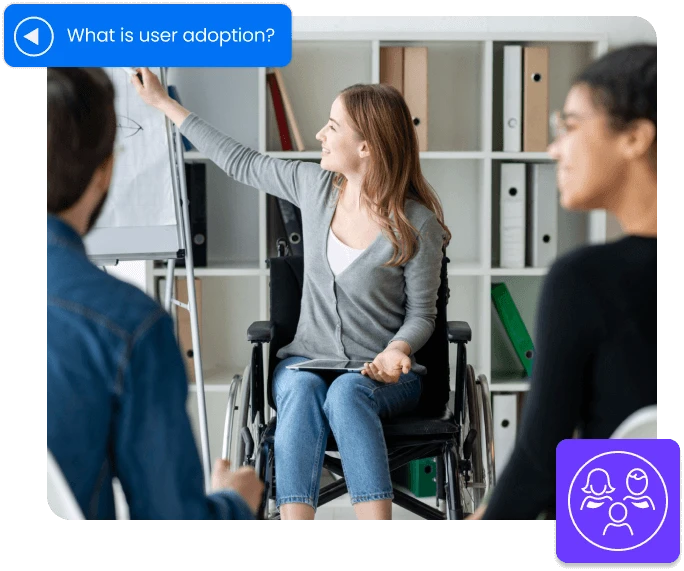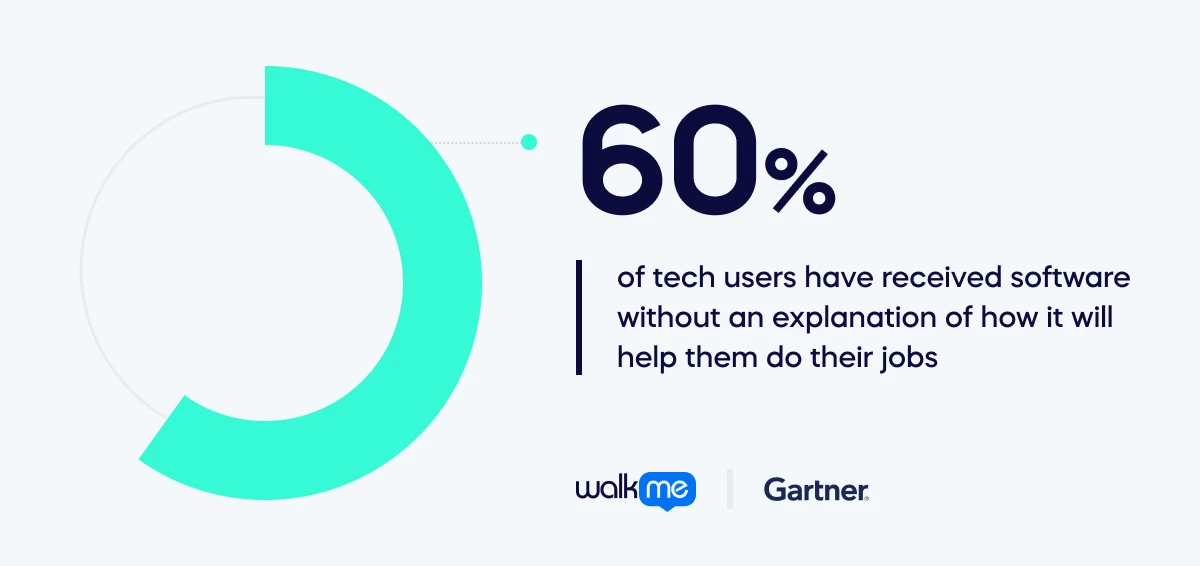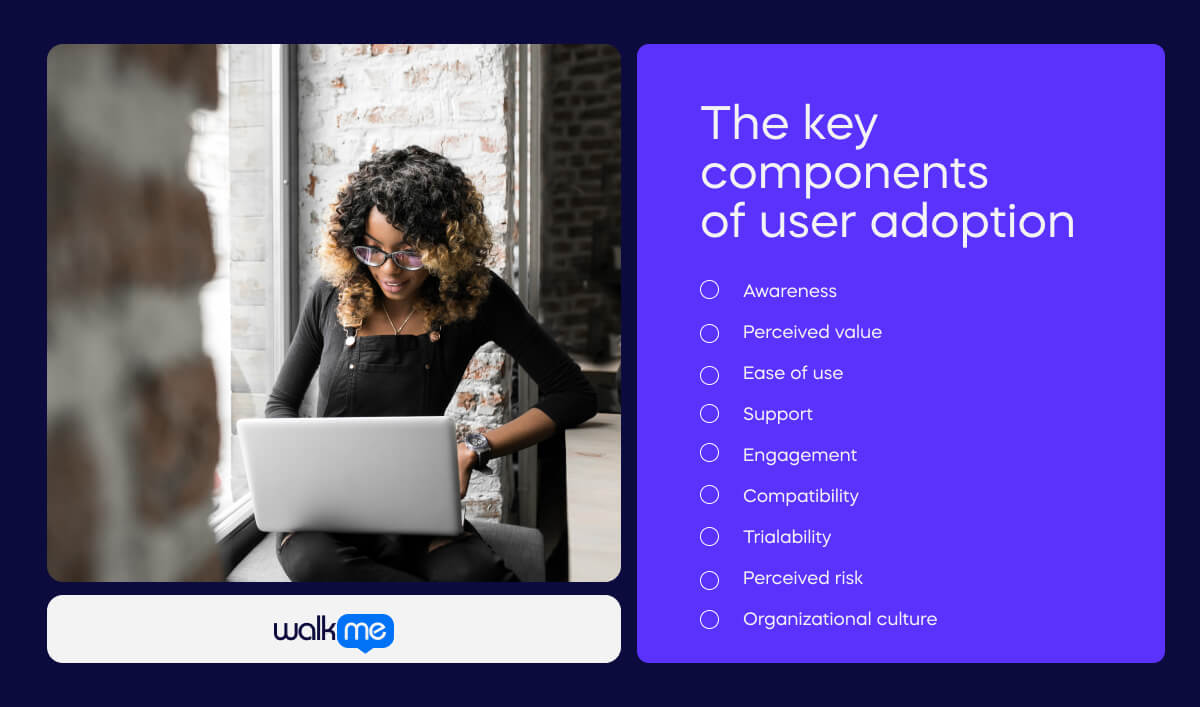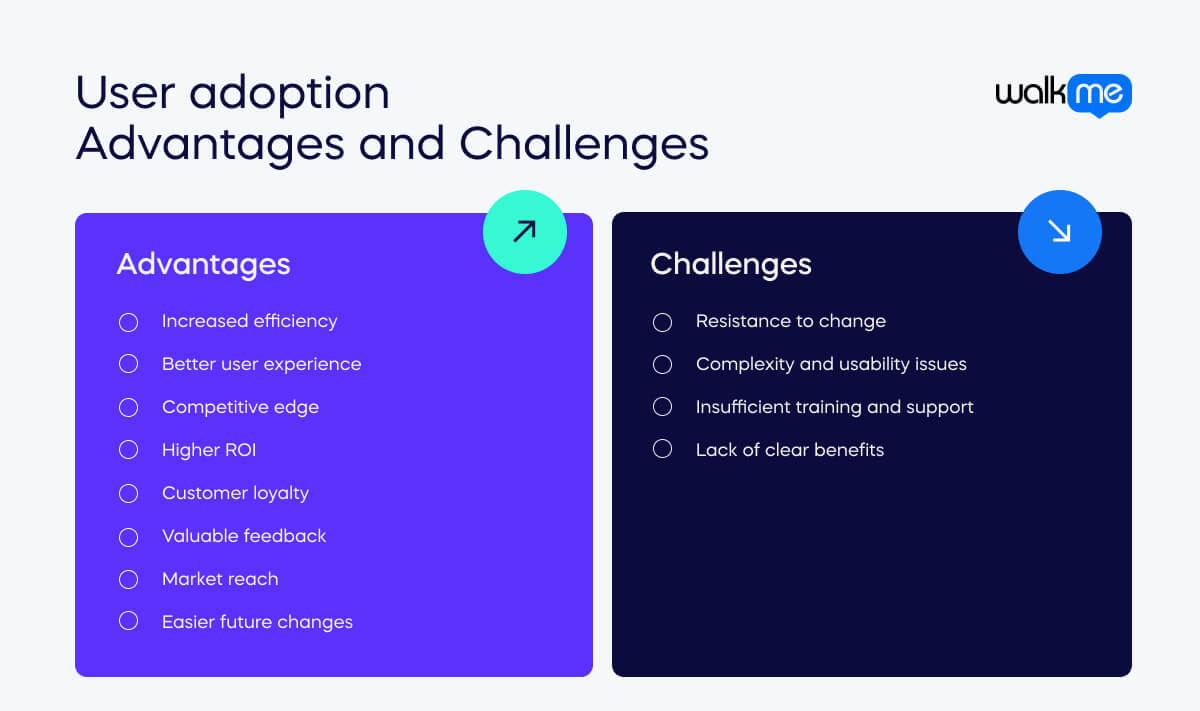What is user adoption?
User adoption means people or groups start using a new product or service in their daily lives. It begins when people first learn about the new product. Then, they try it out and eventually use it regularly.

Table of contents
For user adoption to succeed, the new product or technology must be easy to use and clearly show its benefits. Support, training, and addressing any concerns are crucial to helping users feel comfortable and confident. Good communication about the advantages and practical uses of the new item also plays a key role.

This doesn’t always happen—Gartner reveals that 60% of tech users have received software without an explanation of how it will help them do their jobs. When users experience the benefits and find the transition smooth, they are more likely to adopt it fully. This leads to greater success and sustainability for the new product or service. Considering technology adoption forecasts, good user adoption processes will be vital. Statista reveals that around 75% of companies are likely or highly likely to adopt big data analytics, cloud computing, e-commerce, digital trade, and AI technologies between now and 2027.
What are the key components of user adoption?

To fully grasp the process of user adoption, it’s essential to examine the specific components that influence it. These include various factors that impact how users first learn about, perceive, and interact with new products or technologies. Let’s examine these key components in detail, exploring how each contributes to a successful adoption strategy.
Awareness
The first component of user adoption is awareness. This involves ensuring that potential users know about the new product or technology. Effective marketing and communication strategies are essential for making people aware of its existence and its potential benefits.
Perceived value
Perceived value is crucial for user adoption. Users need to see clear benefits and advantages of the new offering. If the product or technology effectively addresses a specific need or problem, users are more likely to consider adopting it.
Ease of use
Another key component is ease of use. The new product or technology should be user-friendly and integrate seamlessly into existing practices. A complicated or difficult-to-use solution can deter users from adopting it.
Support
Providing support is vital to user adoption. This includes offering training, resources, and assistance to help users transition smoothly. Effective support ensures that users can effectively utilize the new product or technology and address any issues they encounter.
Engagement
Engagement involves actively involving users in the adoption process. This includes gathering feedback, listening to user needs, and making necessary improvements. Engaged users are more likely to embrace the new product or technology and provide valuable insights for its enhancement.
Compatibility
This is about how well the new product fits with what users are already using or how it matches their needs. If the new tool works well with existing systems or practices, users are more likely to adopt it.
Trialability
Trialability means allowing users to test the new product or technology before fully committing. A trial or demo can help users see the benefits and feel more confident about adopting it.
Perceived risk
Perceived risk refers to users’ concerns about costs or reliability. Addressing these worries helps reduce hesitation and encourages adoption.
Organizational culture
For organizations, the overall attitude towards change can impact adoption. A culture that supports new ideas and changes makes it easier for new technologies to be accepted and used.
User adoption vs user engagement
User adoption and user engagement are related but distinct concepts.
- User adoption is about getting people to start using a new product or service.
- User engagement focuses on keeping users actively involved and satisfied over time.
Let’s compare these two terms in more detail.
| User adoption | User engagement | |
| Definition | The process by which users start using and integrating a new product, service, or technology into their daily routines. It focuses on the initial acceptance and use of the offering. | The ongoing interaction between users and a product, service, or technology. It involves the depth and quality of the user’s involvement over time, beyond the initial adoption phase. |
| Focus | Getting users to start using a new product or technology. It is concerned with overcoming barriers to entry and ensuring that users begin integrating the new offering into their practices. | Maintaining and enhancing the interaction between users and the product or service. It aims to keep users actively involved, satisfied, and loyal over time. |
| Techniques | Awareness campaigns Offering trials or demos Simplifying onboarding processes Providing initial training and support These techniques help users get started and feel comfortable with the new offering. | Ongoing communication Personalized content Regular updates Features that encourage frequent use Engaging users through feedback loops, rewards, and community-building activities is crucial in maintaining their interest and involvement. |
| Goals | Achieve initial acceptance and integration of the new product or technology Convert potential users into active users who start using the offering regularly | Deepen the relationship between users and the product Increase user satisfaction Foster long-term loyalty Keep users actively involved and committed to the product or service over time |
| Examples of use | Offering a free trial of a new software tool Running promotional campaigns to raise awareness of a new app Providing onboarding assistance to help new users get started | Sending regular updates and personalized recommendations to app users Running loyalty programs or gamification elements to keep users coming back Engaging with users through forums or social media to gather feedback and build a community |
Use cases for user adoption
In exploring user adoption, it’s helpful to look at how it manifests across different business scenarios. Each situation presents unique challenges and opportunities for getting users to start and continue using a new product or service. The following examples illustrate how user adoption plays out in various contexts, from implementing new software in a workplace to launching a new smartphone and upgrading an e-commerce platform. Each example highlights specific actions and outcomes that demonstrate successful adoption in action.
New software at work
- Employees attend training sessions to learn how to use the new software effectively.
- They start incorporating the software into their daily tasks, such as project management or data entry.
- The software is integrated into existing workflows, with employees adapting their processes to fit the new tool.
- Employees provide feedback, leading to adjustments and improvements in how the software is used or supported.
Smartphone release
- The tech company runs advertisements, promotions, and offers to create buzz around the new smartphone.
- Users of older models decide to upgrade to the new smartphone, demonstrating initial adoption.
- Customers begin using new smartphone features, such as advanced camera functions or updated apps.
- Sales figures and customer reviews reflect how well the smartphone is being adopted and appreciated by the market.
Online store upgrade
- Customers create accounts on the new e-commerce platform to access its features.
- Users explore and use new features like personalized recommendations and a faster checkout process.
- Customers make purchases through the upgraded platform, showing they’ve adopted the new system for their shopping needs.
- Customers provide feedback on the new platform, which helps the company refine and improve the user experience based on their input.

What are the advantages of user adoption?
Understanding the advantages of user adoption is crucial for recognizing its impact on both users and businesses. The benefits extend beyond just getting users to start using a new product or technology. Successful user adoption increases efficiency, better user experiences, and a competitive edge, among other advantages. By examining these benefits, we can see how widespread adoption enhances operational outcomes and contributes to long-term success and growth.
Increased efficiency
When users fully adopt new tools or technologies, it often leads to smoother and more efficient operations, improving productivity.
Better user experience
Adoption ensures users can take full advantage of new features, making their experience more enjoyable and satisfying.
Competitive edge
Businesses with high user adoption can stand out in the market. By using the latest innovations, they gain an advantage over competitors.
Higher ROI
Full adoption helps businesses get more value from investing in new products or services. The benefits of widespread use outweigh the initial costs.
Customer loyalty
High adoption rates for consumer products can lead to increased customer loyalty and retention. Satisfied users are more likely to stick with the product.
Valuable feedback
When many users adopt a new offering, it provides more feedback for improving the product and making it better in the future.
Market reach
Successful adoption helps businesses reach more people. As a result, it increases their market share and visibility.
Easier future changes
High adoption means users are already comfortable with change. This makes it easier to introduce new updates or innovations later.
What are the challenges of user adoption?
Addressing user adoption challenges is crucial for overcoming barriers and ensuring the successful integration of new products or technologies. Various obstacles can impede the adoption process, from resistance to change and usability issues to integration challenges and cost concerns. Understanding these challenges helps in developing strategies to facilitate smoother transitions and improve overall adoption success.
Resistance to change
Users often resist adopting new tools or processes due to comfort with existing systems or fear of the unknown.
Complexity and usability issues
If a new product or technology is complex or difficult to use, users may struggle to integrate it into their routines.
Insufficient training and support
Without proper training and ongoing support, users may find it challenging to fully understand and utilize the new offering.
Lack of clear benefits
Users are less likely to adopt new products if they don’t see clear benefits or improvements over existing solutions.
How can DAPs help with user adoption?
Digital adoption platforms (DAPs) are crucial in enabling user adoption by providing tailored support and guidance throughout the process. By offering interactive onboarding, contextual help, and personalized training, DAPs address common adoption challenges and enhance the user experience. Let’s explore how DAPs contribute to successful adoption.
Interactive onboarding
DAPs offer step-by-step guidance and interactive tutorials that help users get started with new software or tools. This hands-on approach makes it easier for users to understand and use the product from the beginning.
Contextual help
DAPs provide in-app support and contextual help. Examples include tooltips and walkthroughs, which assist users as they encounter new features or functions. This immediate assistance reduces confusion and improves user experience.
Personalized training
These platforms can deliver customized training based on user roles and needs. This ensures users receive relevant information and training matching their specific tasks and responsibilities.
Performance analytics
DAPs track user interactions and performance, providing insights into how users engage with the product. This data helps identify areas where users might struggle and allow for targeted interventions to improve adoption rates.
Seamless integration
DAPs integrate directly into existing systems and help users adapt to new tools without disrupting their current workflows. This integration makes the transition smoother and less disruptive.
Continuous learning
DAPs support ongoing learning and adaptation by offering resources and updates as users become more familiar with the product. This continuous support helps users stay engaged and fully utilize new features.
Success stories with user adoption
WalkMe is adept at helping companies of all shapes and sizes with user adoption projects. Here is one example:
WalkMe x Blackwoods
Blackwoods needed to ensure employees could use the new Microsoft Dynamics platform, but the pandemic lockdowns affected their technology initiative. They tackled this challenge by onboarding WalkMe to develop a tailored change management solution. They wanted to provide moment-in-time guidance, streamline staff training, and improve knowledge retention. The team developed task automation and training materials to streamline workflows. As a result, they have benefited from a 50% faster time-to-proficiency. Furthermore, Customer Care members can now be onboarded twice as quickly.